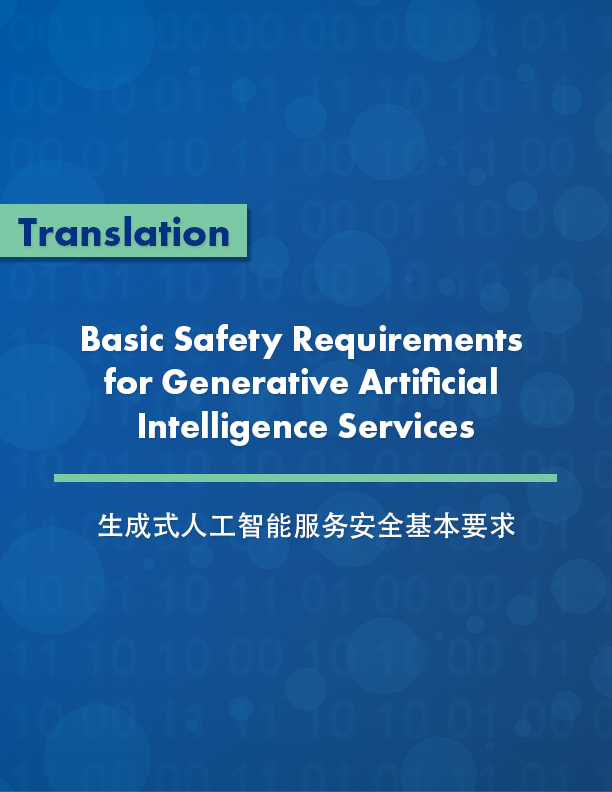The following Chinese technical documentation on generative AI—designed to inform a future Chinese national standard on the topic—establishes very specific oversight processes that Chinese AI companies must adopt in regard to their model training data, model-generated content, and more. The technical documentation names more than 30 specific safety risks, some of which—algorithmic bias, disclosure of personally identifiable information, copyright infringement—are widely recognized internationally. Others, such as guidelines on how to answer questions about China’s political system and Chinese history, are specific to the tightly censored Chinese internet. One notable addition to this documentation, relative to a preliminary draft released in October 2023, is a clause requiring a supply chain security assessment of Chinese generative AI models’ underlying hardware and software.
An archived version of the Chinese source text is available online at: https://perma.cc/GU3Q-GAJ3
Technical Documentation of National Technical Committee 260 on Cybersecurity of Standardization Administration of China: Basic Safety Requirements for Generative Artificial Intelligence Services
Preface
This document is released by National Technical Committee 260 on Cybersecurity of Standardization Administration of China (SAC/TC260).1
This document has been drafted by: China Electronics Standardization Institute (CESI), the National Computer Network Emergency Response Technical Team/Coordination Center of China (CNCERT/CC), Zhongguancun Laboratory (ZGC Lab; 中关村实验室) in Beijing, Zhejiang University, Shanghai Artificial Intelligence Laboratory, Beijing University of Posts and Telecommunications, Beijing Baidu Netcom Science & Technology Co., Ltd., Baichuan AI, Fudan University, Alibaba Cloud Computing Co. Ltd., Shanghai Glow-AI Technology Co., Ltd. (上海稀宇科技有限公司), Shanghai SenseTime Intelligent Technology Co., Ltd., iFlytek Co., Ltd., Shanghai Enflame Technology Co., Ltd., Beijing Knowledge Atlas Technology Co., Ltd. (Zhipu AI; 北京智谱华章科技有限公司), China University of Political Science and Law, DeepLang AI, Beijing Institute of Technology, Shanghai Jiao Tong University, Tsinghua University, the Institute of Software of the Chinese Academy of Sciences (CAS), the CAS Institute of Information Engineering, Beihang University, Beijing Topsec Cybersecurity Technology Co. Ltd. (北京天融信科技集团股份有限公司), Huawei Cloud Computing Technologies Co., Ltd., Ant Group, Beike House-Hunting (Beijing) Technology Co., Ltd. (贝壳找房(北京)科技有限公司), China Cybersecurity Review, Certification and Market Regulation Big Data Center, the Third Research Institute of The Ministry of Public Security, the State Information Center, the Beijing Sub-Center of CNCERT/CC (国家计算机网络与信息安全管理中心北京分中心), Guangzhou Dongyue Information Technology Co., Ltd. (广州动悦信息技术有限公司), China Mobile Limited, Hangzhou Yunlu Knows Technology Co., Ltd.,2 and China Unicom.
The main drafters of this document were: Yao Xiangzhen, Shangguan Xiaoli, Hao Chunliang, Zhang Zhen, Xu Ke, Ren Kui, Yang Min, Chen Yang, Qin Zhan, Tan Zhixing, Zhang Yanting, Wang Zhibo, Zhou Linna, Yang Zhongliang, Cheng Jin, Bao Chenfu, Zhang Linghan, Sun Yanxin, Peng Tao, Qiu Xipeng, Jiang Hui, He Yanzhe, Yang Guang, Zhao Yunwei, Hong Yanqing, Wang Shijin, Guo Jianling, Xu Hao, Peng Juntao, Mei Jingqing, Huo Qichao, Xu Xiaogeng, Wang Jiao, Wang Fengjiao, Zhang Mi, Zhang Yuan, Zhang Liwu, Wang Rui, Jia Kai, Zhao Jing, Shi Lin, Zhang Yan, Xue Zhihui, He Yongchun, Lin Guanchen, Wang Yuchen, Zheng Zimu, Zhang Yutong, Yang Yuchen, Xu Huiyu, Wang Xiaochen, Zhao Ruibin, Jiang Weiqiang, Ding Zhiguo, Liu Nan, Liu Xiyao, Kang Yongmeng, Cao Dongou, Wu Nianjing, and Tao Ye.
Basic Safety3 Requirements for Generative Artificial Intelligence Services4
1 Scope
This document specifies the basic requirements for the safety aspects of generative artificial intelligence (AI) services, including corpus safety (预料安全), model safety, and safety measures, and provides safety assessment requirements.
This document applies to service providers carrying out safety assessments and improving their safety levels, and also provides the relevant main oversight department (主管部门) a reference for judging the safety levels of generative AI services.
To view the rest of this translation, download the pdf below.
Download Full Translation
Technical Documentation of National Technical Committee 260 on Cybersecurity of Standardization Administration of China: Basic Safety Requirements for Generative Artificial Intelligence Services- Translator’s note: This translation uses the English translation “National Technical Committee 260 on Cybersecurity of Standardization Administration of China”—from the masthead of the SAC/TC260 website, https://www.tc260.org.cn/—for the Chinese organization 全国网络安全标准化技术委员会. An apparent alternate (or former) name of this organization is “the National Information Technology Standardization Technical Committee” (全国信息安全标准化技术委员会).
- Translator’s note: Hangzhou Yunlu Knows Technology Co., Ltd. (杭州云麓知道科技有限公司) changed its name to Hangzhou kOS Technology Co., Ltd. (杭州半个宇宙科技有限公司) on December 12, 2023.
- Translator’s note: The Chinese word 安全 ānquán—found in the title of this technical documentation and throughout its text—can be translated into English as either “safety” or “security.” The Chinese authors of this documentation provided the following English translation of its title: “Basic security requirements for generative artificial intelligence service.” However, this CSET English translation renders 安全 as “safety” in most cases, because in the context of this technical documentation, the authors are mainly discussing the prevention of accidents or unforeseen problems (“safety”) of generative AI, rather than the prevention of deliberate abuse or sabotage (“security”).
- Translator’s note: CSET translated an earlier, draft version of this technical documentation in fall 2023: https://cset.georgetown.edu/publication/china-safety-requirements-for-generative-ai/.
